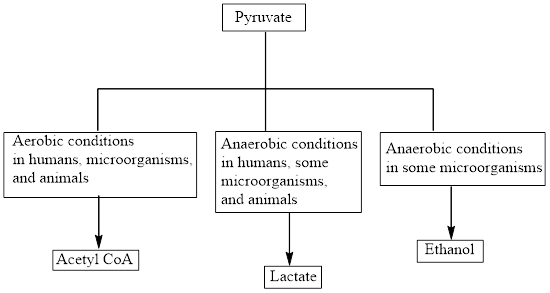
Organic And Biological Chemistry
7th Edition
ISBN: 9781305081079
Author: STOKER, H. Stephen (howard Stephen)
Publisher: Cengage Learning,
expand_more
expand_more
format_list_bulleted
Concept explainers
Question
Chapter 13, Problem 13.44EP
Interpretation Introduction
Interpretation: To determine the overall reaction equation for the conversion of pyruvate to lactate.
Concept introduction: Pyruvate is the end product in the glycolysis. The production of the fate of pyruvate varies with the nature of the organism and the cellular conditions. The three common fates of pyruvate are as follows:

Aerobic reactions need oxygen while anaerobic reactions don’t need oxygen. Pyruvate forms
The fermentation process is an alternative method that oxidized NADH to
Expert Solution & Answer
Trending nowThis is a popular solution!

Chapter 13 Solutions
Organic And Biological Chemistry
Ch. 13.1 - The primary site within the human body where...Ch. 13.1 - What is the first site within the human body where...Ch. 13.1 - What effect does gastric juice in the stomach have...Ch. 13.1 - The enzymes that convert disaccharides to...Ch. 13.1 - Which of the following substances is needed for...Ch. 13.2 - Prob. 1QQCh. 13.2 - Prob. 2QQCh. 13.2 - Prob. 3QQCh. 13.2 - Prob. 4QQCh. 13.2 - Prob. 5QQ
Ch. 13.2 - Prob. 6QQCh. 13.2 - Prob. 7QQCh. 13.3 - Prob. 1QQCh. 13.3 - Prob. 2QQCh. 13.3 - Prob. 3QQCh. 13.3 - Prob. 4QQCh. 13.3 - Accumulation of which of the following substances...Ch. 13.4 - Prob. 1QQCh. 13.4 - The net yield of ATP for the complete oxidation of...Ch. 13.4 - Prob. 3QQCh. 13.5 - Prob. 1QQCh. 13.5 - Prob. 2QQCh. 13.5 - Prob. 3QQCh. 13.6 - Prob. 1QQCh. 13.6 - Prob. 2QQCh. 13.6 - Prob. 3QQCh. 13.6 - Which of the following statements about ATP...Ch. 13.6 - Which of the following substances are participants...Ch. 13.7 - Prob. 1QQCh. 13.7 - Prob. 2QQCh. 13.8 - Prob. 1QQCh. 13.8 - Prob. 2QQCh. 13.8 - Prob. 3QQCh. 13.9 - Which of the following hormones promotes the...Ch. 13.9 - Which of the following pairs of hormones increases...Ch. 13.10 - Prob. 1QQCh. 13.10 - Prob. 2QQCh. 13.10 - Prob. 3QQCh. 13 - Where does carbohydrate digestion begin in the...Ch. 13 - Prob. 13.2EPCh. 13 - Prob. 13.3EPCh. 13 - Prob. 13.4EPCh. 13 - Prob. 13.5EPCh. 13 - Prob. 13.6EPCh. 13 - Prob. 13.7EPCh. 13 - Prob. 13.8EPCh. 13 - Prob. 13.9EPCh. 13 - Prob. 13.10EPCh. 13 - Prob. 13.11EPCh. 13 - Prob. 13.12EPCh. 13 - Prob. 13.13EPCh. 13 - Prob. 13.14EPCh. 13 - Prob. 13.15EPCh. 13 - Prob. 13.16EPCh. 13 - Prob. 13.17EPCh. 13 - Prob. 13.18EPCh. 13 - Prob. 13.19EPCh. 13 - Prob. 13.20EPCh. 13 - Prob. 13.21EPCh. 13 - Prob. 13.22EPCh. 13 - Prob. 13.23EPCh. 13 - Prob. 13.24EPCh. 13 - Prob. 13.25EPCh. 13 - Prob. 13.26EPCh. 13 - Prob. 13.27EPCh. 13 - Why is Step 3 of glycolysis called the commitment...Ch. 13 - Prob. 13.29EPCh. 13 - Prob. 13.30EPCh. 13 - Prob. 13.31EPCh. 13 - Prob. 13.32EPCh. 13 - Prob. 13.33EPCh. 13 - Prob. 13.34EPCh. 13 - Prob. 13.35EPCh. 13 - Prob. 13.36EPCh. 13 - Prob. 13.37EPCh. 13 - Prob. 13.38EPCh. 13 - Prob. 13.39EPCh. 13 - Prob. 13.40EPCh. 13 - Prob. 13.41EPCh. 13 - Prob. 13.42EPCh. 13 - Prob. 13.43EPCh. 13 - Prob. 13.44EPCh. 13 - Prob. 13.45EPCh. 13 - Prob. 13.46EPCh. 13 - Prob. 13.47EPCh. 13 - Prob. 13.48EPCh. 13 - Prob. 13.49EPCh. 13 - Prob. 13.50EPCh. 13 - Prob. 13.51EPCh. 13 - Prob. 13.52EPCh. 13 - Prob. 13.53EPCh. 13 - Prob. 13.54EPCh. 13 - Prob. 13.55EPCh. 13 - Prob. 13.56EPCh. 13 - Prob. 13.57EPCh. 13 - Prob. 13.58EPCh. 13 - Prob. 13.59EPCh. 13 - Prob. 13.60EPCh. 13 - Prob. 13.61EPCh. 13 - Prob. 13.62EPCh. 13 - Prob. 13.63EPCh. 13 - Prob. 13.64EPCh. 13 - What is the difference between the processing of...Ch. 13 - Prob. 13.66EPCh. 13 - Prob. 13.67EPCh. 13 - Prob. 13.68EPCh. 13 - Prob. 13.69EPCh. 13 - Prob. 13.70EPCh. 13 - Prob. 13.71EPCh. 13 - Prob. 13.72EPCh. 13 - Prob. 13.73EPCh. 13 - Prob. 13.74EPCh. 13 - Prob. 13.75EPCh. 13 - Prob. 13.76EPCh. 13 - Prob. 13.77EPCh. 13 - Prob. 13.78EPCh. 13 - Prob. 13.79EPCh. 13 - Prob. 13.80EPCh. 13 - Prob. 13.81EPCh. 13 - Prob. 13.82EPCh. 13 - Prob. 13.83EPCh. 13 - Prob. 13.84EPCh. 13 - Prob. 13.85EPCh. 13 - Prob. 13.86EPCh. 13 - Prob. 13.87EPCh. 13 - Prob. 13.88EPCh. 13 - Prob. 13.89EPCh. 13 - Prob. 13.90EPCh. 13 - Prob. 13.91EPCh. 13 - Prob. 13.92EPCh. 13 - Prob. 13.93EPCh. 13 - Prob. 13.94EPCh. 13 - Prob. 13.95EPCh. 13 - Prob. 13.96EPCh. 13 - Prob. 13.97EPCh. 13 - Prob. 13.98EPCh. 13 - Prob. 13.99EPCh. 13 - Prob. 13.100EPCh. 13 - Prob. 13.101EPCh. 13 - Prob. 13.102EPCh. 13 - Prob. 13.103EPCh. 13 - Prob. 13.104EPCh. 13 - Prob. 13.105EPCh. 13 - Prob. 13.106EPCh. 13 - Prob. 13.107EPCh. 13 - What effect does insulin have on blood-glucose...Ch. 13 - Prob. 13.109EPCh. 13 - Prob. 13.110EPCh. 13 - Prob. 13.111EPCh. 13 - Prob. 13.112EPCh. 13 - Prob. 13.113EPCh. 13 - What is the relationship between cAMP and the...Ch. 13 - Prob. 13.115EPCh. 13 - Compare the biological functions of glucagon and...Ch. 13 - Prob. 13.117EPCh. 13 - Prob. 13.118EP
Knowledge Booster
Learn more about
Need a deep-dive on the concept behind this application? Look no further. Learn more about this topic, chemistry and related others by exploring similar questions and additional content below.Recommended textbooks for you
 Organic And Biological ChemistryChemistryISBN:9781305081079Author:STOKER, H. Stephen (howard Stephen)Publisher:Cengage Learning,
Organic And Biological ChemistryChemistryISBN:9781305081079Author:STOKER, H. Stephen (howard Stephen)Publisher:Cengage Learning, General, Organic, and Biological ChemistryChemistryISBN:9781285853918Author:H. Stephen StokerPublisher:Cengage Learning
General, Organic, and Biological ChemistryChemistryISBN:9781285853918Author:H. Stephen StokerPublisher:Cengage Learning Chemistry for Today: General, Organic, and Bioche...ChemistryISBN:9781305960060Author:Spencer L. Seager, Michael R. Slabaugh, Maren S. HansenPublisher:Cengage Learning
Chemistry for Today: General, Organic, and Bioche...ChemistryISBN:9781305960060Author:Spencer L. Seager, Michael R. Slabaugh, Maren S. HansenPublisher:Cengage Learning

Organic And Biological Chemistry
Chemistry
ISBN:9781305081079
Author:STOKER, H. Stephen (howard Stephen)
Publisher:Cengage Learning,

General, Organic, and Biological Chemistry
Chemistry
ISBN:9781285853918
Author:H. Stephen Stoker
Publisher:Cengage Learning

Chemistry for Today: General, Organic, and Bioche...
Chemistry
ISBN:9781305960060
Author:Spencer L. Seager, Michael R. Slabaugh, Maren S. Hansen
Publisher:Cengage Learning
